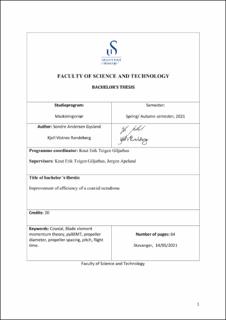| dc.description.abstract | The goal of this thesis is to find the optimal coaxial configuration for Nordic Unmanned´s
drone Staaker BG200. Research has shown that the parameters propeller spacing and
diameter, are factors that have the greatest impact on efficiency, as well as being parameters
that can be optimized on the Staaker BG200. This thesis aims to improve the efficiency of
a coaxial unmanned aerial vehicle and consequently extending the flight time. This will be
achieved by a theory that describes the interaction between the propellers and analysis of
experimental data.
Based on the literature study, testing hovering performance and communication with Nordic
Unmanned the test plan was developed. Testing of every configuration of 28", 30" and 32"
propeller was completed, with five different distances. The tests were performed on a test
rig at UiS, which is capable of measuring a number of variables including thrust and power.
Every test was driven by a test script that started the propellers at 24 Newtons of thrust,
take sixteen steps, ending at 99 Newtons and record data points at every stop to a CSV-file.
Analyzing the results from the CSV-file, the result indicate that the configuration Nordic
Unmanned are using today, with two 28" propellers, is not efficient compared to larger
propeller sizes. However, the spacing between the propellers is sufficient.
Through analysing the results, Nordic Unmanned may improve their flight time with about
10 % or 2.6 minutes extra flight time if they change Staaker BG200s propeller from two 28"
propellers to two 30" propellers, with the distance of 109.2 mm which they are using today.
Further research using a more powerful motor is needed to see if the efficiency of the 32"
propeller changes. Tests should also be performed in a wind tunnel to see the influence of
forward flight. | |
